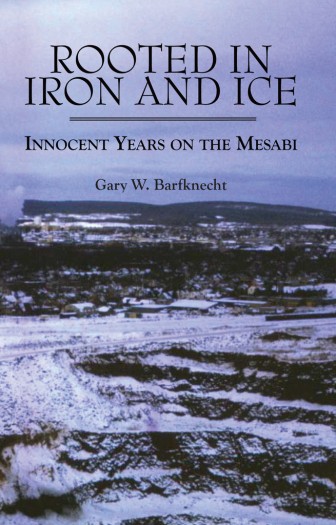Capital News Service

Rooted in Iron and Ice: Innocent Years on the Mesabi by Gary Barfknecht. Image: Capital News Service
For writer Gary Barfknecht, growing up after World War II on the Mesabi Iron Range of Northern Minnesota meant bitter-cold winters, the uncertainties of a mining economy, wandering lost in the backcountry, learning to hunt, playing hockey and making the most of short summers.
His new memoir, “Rooted in Iron and Ice: Innocent Years on the Mesabi” (North Star Press of St. Cloud, $14.95), describes the region as a “frigid, isolated, inhospitable strip of mineral wealth,” making up a “small, insular foreign country with its own culture, language and one-of-a-kind terrain.”
Barfknecht said his experiences in Virginia, Minn. — nicknamed “Queen City of the Range” — are similar to those of contemporaries who grew up during the same era in the Western Upper Peninsula. Both had similar climate, similar economies, similar wildernesses and similar mixes of dozens of ethnic groups drawn by the mines’ huge demand for labor.
“Iron mining started in the western U.P. As those mines started to tap out, those miners started to move to Minnesota,” he said. “I really identify with that part of the U.P. Every time we go to visit, I revel in watching the people there. I see people like my dad and friends and mother.”
Barfknecht, who divides his time between Petoskey, Mich., and the coincidentally named state of Virginia, is the author of more than a half-dozen nonfiction books about Michigan, including “Murder, Michigan,” “Michillaneous” and “39 Petoskey Walkabouts.” The company he founded, Friede Publications, published 18 books about the state by Michigan authors, including fishing and canoeing guides.
Gary Barfknecht on winter:
“The concept of enduring such cold is incomprehensible. But we were born into it. It was our reality. Not only did we not complain, we took pride in our hardiness. And it turns out we did, in fact, physiologically acclimatize.
When scientists finally warmed up to cold research, they discovered that people like us, subjected to frigid temperatures over time, did develop an increased tolerance. We metabolically generated more heat, more efficiently than outsiders.”
From “Rooted in Iron and Ice: Innocent Years on the Mesabi”
He moved to Michigan after college to work as a paint chemist for E.I. du Pont in Flint.
“I had this idea for a long, long time,” he said of the memoir. “I’ve never felt so driven to write a book. I didn’t want to make it about me. I wanted to use my experiences to show what life was like there for many people.”
Much of “Rooted in Iron and Ice” is in the form of what he calls a “reconstructed journal,” adding, “the memories are real. Most are mine. Some of them my parents had to help me with, and others.”
The events recounted in the memoir are “absolutely real,” with some verified by documentation such as weather reports, he said. “Often I could recall from other things what else was going on around that time, such as the first day at school.”
Winters, not surprisingly, play a major role in the book.
For example, he described a rabbit-snaring expedition when an unexpected snowstorm and early sunset left him and two friends wandering in the dark woods, crossing a creek that soaked their boots, dead-reckoning their way to a field and then to a road and then to a farmhouse.
So much for his mother’s standard admonition before they set off: “Don’t get lost.”
The book also listed the daily temperatures for January 1959 — 31 was the warmest day — plunging on another day to minus 32. That’s right: never above freezing, an average low of minus 10.5 degrees and an average high of 12.3
Barfknecht said he wrote the book primarily for readers who are unfamiliar with the Mesabi because when he discussed his childhood with them, “people didn’t believe it was possible for your eyes to freeze shut — it was so cold.”
